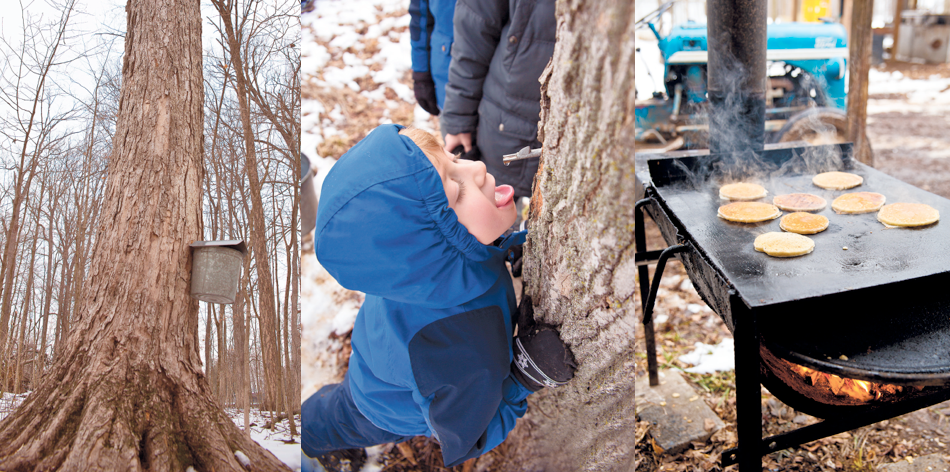Sweet Preview of Spring
When the winds howl, and the snow refuses to melt, and we’re all desperate for warmer weather, it’s hard to believe that spring will ever arrive. However, nature knows better. Deep within the maple trees, going back since the beginning of time, the sap is running. Drip by delicious drip, it’s a sign that spring is on its way.
Our family took a day trip to Yoder’s Sugar Bush in Huntertown, near Fort Wayne, Indiana. It’s a maple syrup–making operation that’s been in the family for five generations. The family farm spans about 400 acres, with over 200 trees tapped for syrup. As we trudged back a long and muddy lane, I felt as if we were going back in time. We were there to see how syrup gets made, from start to mouthwatering finish, and they put us right to work.
The trees stretched to the sky, with buckets hanging to catch the sap. Erika (Yoder) Meyer and her husband, Tom, were our guides for the day. “Go ahead and taste the sap straight from the tree if you want,” Erika encouraged, “just make sure you don’t contaminate the spout by touching it.” The sap was very cold, tasting like slightly sweetened water.
Larry Yoder, Erika’s dad, showed us how he taps the trees (drills) to get the sap in the first place. Each year the tree needs to be drilled in a different spot, so it can heal from the last season. After drilling, a spile is placed into the tree and a bucket hangs on that. You know when it’s time to start drilling by paying attention to the weather. When the nights are still at or below freezing and the daytime temps go above freezing, it’s time. This pattern of freeze-thaw-freeze-thaw is what starts the sap flowing in the
trees.
After collecting the sap from the full buckets, it was time to go to the sugaring house. We smelled the smoke and watched it rise into the chilly air. Once inside, it was cozy, warm and steamy, smelling faintly of caramel corn. The wood-burning evaporator boils down the sap into syrup. Long ago folks used to have to stir the sap constantly to keep it from burning. Now, this machine keeps the liquid moving all on its own. We could hear
the gurgling, boiling sap, and see how it went from clear (in one bin) to light amber (in the final bin). It takes about 40 gallons of sap to make just one gallon of syrup, but the reward for all that patience and hard work is delicious.
Speaking of delicious, we ended our time together with a reward of pancakes and (you guessed it) maple syrup. These cakes were cooked on a cast-iron griddle over an open flame. I think the combination of that plus working up such an appetite made these the best pancakes i’ve ever tasted. We wolfed them down like we hadn’t eaten for days. so have faith. Be patient. and watch for signs of spring. Believe it or not, it’s coming!
YODER FARM
1818 Wendmere Ln., Fort Wayne, IN
farm@yoderfarm.com | YoderFarm.com




